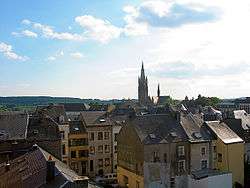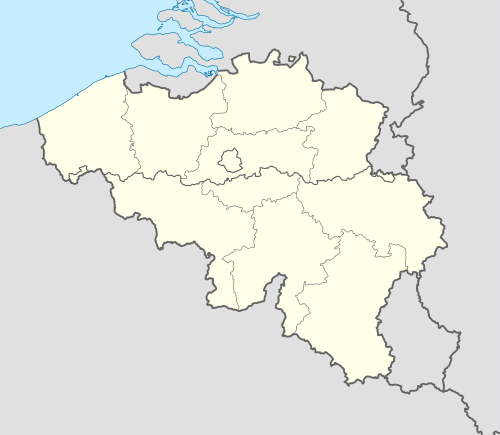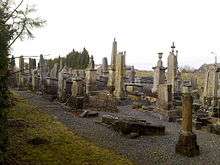Arlon
Arlon (French pronunciation: [aʁlɔ̃]; Luxembourgish: Arel, pronounced [ˈaːʀəl] (![]()
Arlon | |
|---|---|
 Arlon centre with bell tower of St. Martin's Church | |
 Flag  Coat of arms | |
 Arlon Location in Belgium
Location of Arlon in Luxembourg province  | |
| Coordinates: 49°41′N 05°49′E | |
| Country | Belgium |
| Community | French Community |
| Region | Wallonia |
| Province | Luxembourg |
| Arrondissement | Arlon |
| Government | |
| • Mayor | Vincent Magnus (cdH) |
| • Governing party/ies | cdH, PS |
| Area | |
| • Total | 118.64 km2 (45.81 sq mi) |
| Population (2018-01-01)[1] | |
| • Total | 29,733 |
| • Density | 250/km2 (650/sq mi) |
| Postal codes | 6700, 6704, 6706 |
| Area codes | 063 |
| Website | www.arlon.be (in French) |
The municipality consists of the following sub-municipalities: Arlon proper, Autelbas-Barnich, Bonnert, Guirsch, Heinsch, and Toernich. Other population centers include:
- Autelhaut
- Clairefontaine
- Fouches
- Frassem
- Freylange
- Heckbous
- Rosenberg
- Sampont
- Schoppach
- Sesselich
- Seymerich
- Stehnen
- Sterpenich
- Stockem
- Udange
- Viville
- Waltzing
- Weyler
- Wolberg
History
Roman Empire 57BCE-395
Western Roman Empire 395-480
Francia 481-843
Middle Francia 843-855
![]()
![]()
County of Arlon 950–1214
![]()
![]()
![]()
![]()
![]()
![]()
(Margraviate) County of Arlon | |||||||||
|---|---|---|---|---|---|---|---|---|---|
| 950–1221 | |||||||||
| Status | County | ||||||||
| Capital | Arel (Arlon) | ||||||||
| Government | Principality | ||||||||
| Historical era | Middle Ages | ||||||||
• Established | 950 | ||||||||
• Raised to margraviate | ca 1167 | ||||||||
• United with the County of Luxemburg | 1214 | ||||||||
• Annexed to the Duchy of Luxembourg | 1221 | ||||||||
| |||||||||
Roman and medieval times
Before the Roman conquests of Gaul, the territory of Arlon and a vast area to the southeast were settled by the Treveri, a Celtic tribe. The local population adapted relatively easily to Roman culture. The number and quality of sculpted stones and monuments that have been unearthed in the area demonstrate that the vicus of Orolaunum quickly became a vibrant commercial and administrative centre of Roman civilization. The Germanic invasions of the 3rd century destroyed most of these early advances, despite the defensive walls that had been built on the Knipchen hill to protect the vicus.
During most of the Middle Ages, the population still used the earlier buildings such as the thermae. In 1060, Waleran I of Limburg, Count of Arlon, built a castle on the Knipchen hill. In the 13th century, the only women's Cistercian abbey known to date was built in Clairefontaine.
15th century until the French Revolution
The Duchy of Luxembourg itself, of which Arlon was dependent, became part of the Burgundian Netherlands under Philip the Good in 1441. After Charles V's abdication of his empire to his son Philip II of Spain in 1556, a troubled period started for the whole region as continuous wars opposed France, Spain, and the Southern Netherlands. In 1558, nearly half of the city, including its castle, was destroyed by the French troops of Duke François of Guise. In the 17th century, Capuchin friars built a convent on the ruins of the castle and the French strengthened the defensive walls according to Vauban's designs. An accidental fire destroyed a large part of the city again in 1785.

Modern times
On 9 June 1793 the French Revolutionary troops opposed the Austrians just outside Arlon. The French emerged victorious and occupied the city. They expelled the Capuchin friars and used their convent as a hospital. After the Battle of Waterloo, Arlon's history is entwined with that of Belgium.
Arlon was one of the first victims of the German invasion in 1914 as 121 inhabitants were executed on 26 August, on the orders of Colonel Richard Karl von Tessmar. Its territory was again among the first to be invaded at the onset of World War II. During the war, the mayor of Arlon, Paul Reuter collaborated with the occupying Germans. He was shot in 1946.
Arlon today
Being situated very close to the border with the Grand Duchy of Luxembourg, Arlon has continued to expand with new residential areas and commercial development zones, and many people cross the border everyday to work in the Grand Duchy. One of the largest industrial employers is the Ferrero Rocher chocolate factory. All International express trains make a stop in Arlon, as it is the last station on the main Brussels—Luxembourg City railway line.
Sights

- Arlon is best known for holding one of the richest archeological museums in Belgium. It houses numerous examples of Roman sculpture and Merovingian funerary art.
- A fragment of the Gallo-Roman defensive wall that was built in the 3rd century still stands in Arlon.
- The Gaspar Museum is well known for its furniture, paintings, ceramics, and religious art.
- Saint Donat's church now stands on the Knipchen hill, where Waleran I of Limburg once built his castle and the Capuchin friars built their convent.
- Arlon cemetery has the largest Jewish section of all Walloon cemeteries.
- A statue commemorating the Atrocities in the Congo Free State of Leopold II is found in the town.
Local customs
- The carnival of Arlon takes place at mid-Lent. It includes the traditional handing of the city keys to the carnival prince and a colourful parade composed of various folk dance groups.
- The Maitrank (German for "drink of May") is the city's most popular refreshment. It is made of white wine in which a local flower, the Asperula odorata, has macerated. Some recipes also add cognac or substitute woodruff for the Asperula. The Maitrank festivities take place in the city every fourth Sunday of May.
Politics
List of mayors :
- Pierre Hollenfeltz
- 1880-1901 : Joseph Netzer
- 1901-1921 : Numa Ensch-Tesch
- 1921-1949 : Paul Reuter
- 1949-1958 : Jules Massonnet
- 1958-1976 : Charles Simon
- 1977-1988 : Jean Goffinet
- 1989-1992 : Guy Larcier
- 1993-1994 : Jean Goffinet
- 1995-2006 : Guy Larcier
- 2007-2012 : Raymond Biren
- 2013-... : Vincent Magnus
People born in Arlon
- Johann Kaspar Basselet von La Rosée, Bavarian general (1710–1795)
- Godefroid Kurth, historian (1847–1916)
- Benoît Lamy, film director (1945–2008)
- Ingrid Lempereur, swimmer (1969)
- Jeroen van Busleyden, humanist (1470-1517)
- Anthony Moris, Belgian footballer (1990)
- Timothy Castagne, Belgian footballer (1995)
International relations
Twin towns — sister cities
Arlon is twinned with:







References
- "Wettelijke Bevolking per gemeente op 1 januari 2018". Statbel. Retrieved 9 March 2019.
External links
| Wikimedia Commons has media related to Arlon. |
- Official site
- Alternative to official site (in French)
- Official Maitrank web site (in French)
- Official Saint-Martin parish website of Arlon city (in French)
